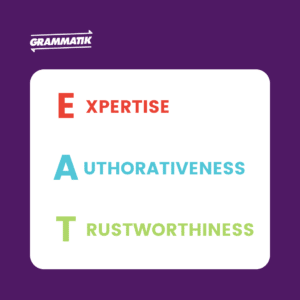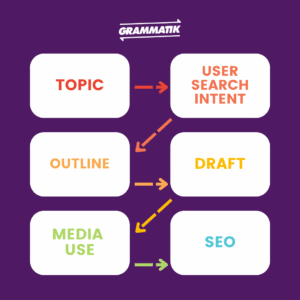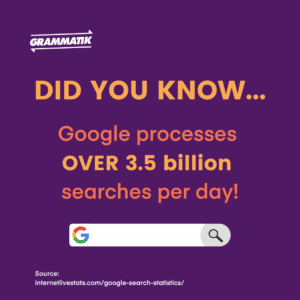
SEO content is a popular term and used daily in many companies, but what is SEO content and how can it help your organisation?
SEO stands for Search Engine Optimisation, where things are easily accessible via search engines such as Google. And, as you would expect, content refers to information on the web, for example, blogs, podcasts and videos.
So, SEO content means information available on a website which has been optimised to be found easily via a search engine.
However, here comes the problem.
Content creators can very easily fall into the trap of creating content for search engines, rather than creating content for their business’ target audience and potential customers, which is then easily found via search engines.
People-first content
Content should always be about meeting the current and potential customer needs. A great place to start is to ensure the business audience has been clearly identified. Here are three great questions to contemplate:
1. Who is your audience?
Think about:
– What are their interests?
– What is the main product or service they need from your organisation
– Where else might they receive their information?
This is a good place to create a customer profile or buyer persona.
2. What level of information is your audience seeking?
Think about:
– How much knowledge the audience is already likely to have
– Is your content primarily meeting these needs?
3. What should your audience feel post-content?
Consider:
– Has your content been geared towards that end feeling? For example, if your content is a ‘how-to guide’ will your consumer walk away feeling able to achieve and confident to succeed?
– Have you provided actionable insights?
Creating SEO content for people, rather than search engines is no easy feat, but it can be done.
3 top tips for SEO content
Top tip 1: Nothing beats an original
Firstly, is this a topic the audience wants to hear about? Or is it something you want to talk about? The former should be your primary consideration. When the two align it’s a perfect scenario but your customers, and potential customers, wants should always come first.
Headlines are important. We know this. An eye-catching, engaging headline is a fundamental requirement for good content, but avoid clickbait. We all know the feeling of coming across a piece of content that sounds great, maybe even too good to be true – in both personal and professional formats – to then find it contains nothing relevant. This will only annoy your audience and damage your credibility with customers.
Down to the details. Content does well when it presents new information, or alternative ways of interpreting and applying existing information rather than regurgitating existing content. Think about what message the content is delivering and what already exists. What new knowledge will your customer walk away with? What additional benefit does this provide?
Length should also be a key consideration. For truly excellent SEO content, longform content ranks significantly higher than the average 400-word blog piece. In a Google rankings signals study, the top 10 pieces of content averaged around 1,447 words. By producing longform content, the length alone will make it stand out from the competition.
E–A–T
Google has a wide range of material available providing advice on how to optimise your content, making it even easier for customers to find.
‘Quality Raters’ are employed by Google, who give feedback on algorithms but have no control over rankings. In particular, raters are trained to evaluate content according to the E–A–T model:

This model refers to:
– The expertise of the creator of the main content
– The authoritativeness of the creator of the main content and the website
– The trustworthiness of the creator of the main content and the website
Including small things, such as author bios, will help boost credibility and position your leadership team as experts within the topic. By explaining why the author is a credible source via their experience, their credibility starts to build and helps them achieve E–A–T status. This is also key for raising overall brand awareness.
Find out more about how Google uses the E–A–T model.
Top tip 2: Let the content fit the format
There are many different types of content, each with their own purpose and format, for example:
1. Blog posts
Blogs posts are among the most popular types of content on the internet. Not only are they very flexible, but they can also be designed and created to fit your needs.
Here are three reasons why blogs are considered important SEO content:
– Every post increases your visibility in an organic search
– Regular posts help to embed credibility
– Regular posts help build and maintain authority
Blog posts are suited for both B2B and B2C organisations and publishing regularly will boost your content, ensuring that it ranks significantly higher.
Having new regular content will increase your website traffic by 350%, according to a blog post from HubSpot.
Blog posts are a great way to achieve engagement, build credibility, and increase brand awareness.
2. ‘How-to’ guides
Typically, a ‘how-to’ guide is a longer, more descriptive piece of content providing insights or instructions on how to achieve an objective or goal.
Guides can be a great way to reach new audiences and generate leads by making them accessible once the potential customer has completed a registration form. However, this can also decrease traffic and SEO ranking due to people leaving the page without completing.
Typically, a ‘how-to’ guide would be structured by linear steps or actions. Language also needs to be a key consideration. Is your audience well-versed in industry jargon? Or do you need to use clear, descriptive terms? Finally, everything within the guide needs to be purposeful. There should be a consistent process of asking ‘why do our customers want or need this information?’.
Why not introduce an editorial calendar to keep track of your content schedule. Take a look at some examples.
Top tip 3: Optimise, Optimise, Optimise
The final top tip for excellent, people-centric SEO content is optimisation which should happen concurrently with top tips 1 and 2.
SEO has rules, and if you follow them correctly, your content will do well. These rules apply to all content available online.
Here are the key points:
Keyword research
Firstly, when picking your topic, make sure you perform keyword research. If you’re trying to increase website traffic through organic searches, your content needs to be geared towards what your audience is already looking for.
Keyword optimisation
Keyword placement is incredibly important. Where should you put your keywords? Where is the most visible, natural and easily accessible place?
Some of the best areas include:
– Page title
– First 100 words
– Headings
– Meta description
Content organisation
When viewing the content offering from a consumer and customer point of view, does the layout of your content make sense? Is it presented in a logical structure or is all of the information intermingled? Does your content reflect the customer journey?
If you’re not sure, ask someone else for their thoughts. If the decision is made to restructure the content layout, this must be aligned to the customer journey and what the information needs are at any one stage.
If content is presented in a logical manner, this not only improves your SEO, but also increases traffic on related content.
Finally, don’t forget to optimise your content for different devices. Content appears differently depending on whether you view it from a laptop, mobile device, or tablet and can even differ depending on operating systems, such as iOS and Android.
If your content is not easy to read or an enjoyable digital experience for your customer, your SEO will suffer and the content will not perform as well.

It’s important to remember that SEO can take time and dramatic improvements will not happen overnight. With a people-centric outlook and the desire to create content for your customers and the desire to attract potential customers, not appease Google’s rankings, your website traffic and engagement will thrive.
Struggling to sort your SEO content? Get in touch with Grammatik Agency today to find out how we can help create impactful campaigns and tailored content to elevate your brand.


©️2024 Grammatik Agency, Second Home, 125–127 Mare St, London E8 3SJ.
[email protected]
+44 (0)20 3950 7057 Privacy policy